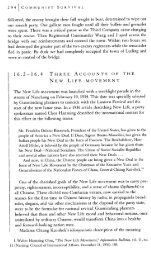Seneca Falls Women's Rights Convention Lesson Plan
Seneca Falls Women's Rights Convention Lesson Plan
Seneca Falls Women's Rights Convention Lesson Plan
Create successful ePaper yourself
Turn your PDF publications into a flip-book with our unique Google optimized e-Paper software.
Who were some of the women opposed to the Removal Act? New England Womenbecause they did not want to see fellow Christians dispossessed of their land andabolitionists who did not want to see Native American lands converted to slave lands.How did women get the word out of their opposition to the Removal Act? Magazinesand church newspapers. Even though the circulation of these magazines and papers wassmall each paper of magazine was typically read by five or six people. The majorperiodicals were:• Methodist Christian Advocate and Journal*—25,000 subscribers• New York Observer (Presbyterian)—6,000 subscribers• American Board of Missionary Herald*—14,000 subscribers*Methodist missionaries had Christianized the Native Americans and therefore had a strong stakein the protection of their Christian brothers and sisters.Opposition to removal gathered steam in early 1830. One of the main reasons wasbecause President Jackson’s statements of wanting to remove the uncivilized Indians tothe west where they would be able to live in their traditional ways were obvious lies.People, particularly those women involved in or aware of the missionary work, knewthe tribes were civilized from reading the magazines.Harriet Beecher, the sister of Catherine Beecher and then a young woman gets involvedin politics for the first time. This experience will eventually lead to her involvement inthe abolitionist movement and the writing of one of the most important anti-slaverybooks ever, Uncle Tom’s Cabin, which she will write and publish under her marriedname, Harriet Beecher Stowe.April 24, 1830: Despite the opposition to the Indian Removal Act both houses ofCongress do pass it on April 24, 1830. However, the vote was close (28-19 in theSenate and 102-97 in the House of Representatives).Long term Outcomes: Even though the women who opposed the Indian Removal Actof 1830 failed in their attempt to prevent its passage, they and the others who workedagainst the Act learned something very important: how to organize a movement. Theskills and connections developed in fighting the Indian Removal Act of 1830 showthemselves in the later abolitionist and women’s rights and suffrage movements.Fun piece of information: Martin Van Buren’s niece was politicized by the fightagainst Indian Removal and tells her uncle that she hopes he and President Jackson losethe election of 1832 because of Jackson’s stand on Indian Removal. Van Buren was theVice Presidential nominee at the time, and he and Jackson did win the election.





